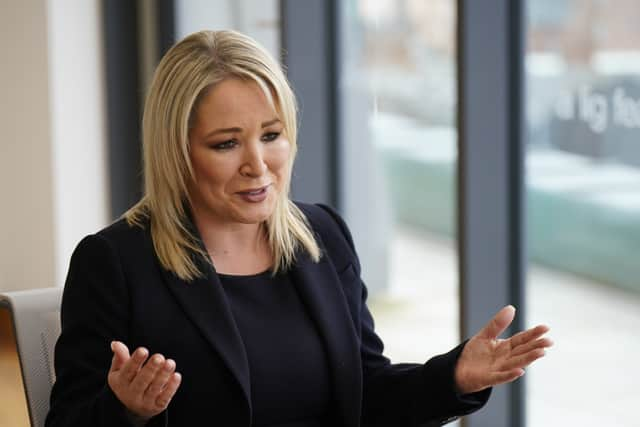Local elections 2023: Northern Ireland’s council elections explained
and live on Freeview channel 276
A fortnight after local elections in England, voters in Northern Ireland are going to the polls on Thursday (18 May) to choose the councillors responsible for services where they live - like collecting bins and managing leisure centres.
NationalWorld has everything you need to know about the elections, what’s at stake and how to take part.
How many seats were up for grab?
Advertisement
Hide AdAdvertisement
Hide Ad462 council seats - which were last contested four years ago - are up for grabs across Northern Ireland’s 11 council areas: Antrim and Newtownabbey, Ards and North Down, Armagh City, Banbridge and Craigavon, Belfast, Causeway Coast and Glens, Derry City and Strabane, Fermanagh and Omagh, Lisburn and Castlereagh, Newry, Mourne and Down, Mid and East Antrim and Mid Ulster.
These councils have a range of responsibilities, from managing parking permits to maintaining parks and making decisions on planning applications.
The ballot was originally scheduled to take place on May 4 - alongside England’s local elections - but was postponed because counting would have clashed with the Coronation.
Sinn Fein emerge as largest party
Sinn Fein has emerged as the largest party in local government in Northern Ireland for the first time after making large gains in the council elections. Vice president Michelle O’Neill described her party’s victory as “momentous” and said the result sent a message that Stormont should return.
Advertisement
Hide AdAdvertisement
Hide AdHowever, DUP leader Sir Jeffrey Donaldson said that his party had polled strongly but conceded unionism needed to learn lessons from the election. The election count crept into a third day with the last of 462 seats to be filled across 11 councils going to People Before Profit shortly after midnight on Sunday (21 May) at Belfast City Hall.
At the end of the count Sinn Fein emerged with 144 seats, an increase of 39 from the last council election in 2019. The republican party has also replicated its result in the Assembly election last year when it became the largest party at Stormont.
The DUP has reinforced its position as the dominant force in unionism by winning 122 seats, the same number as in 2019. The cross-community Alliance Party increased its representation on councils by winning 67 seats, an increase of 14.
But it was a disappointing election for the Ulster Unionists and the SDLP, with both parties suffering significant losses. The UUP has ended up with 54 seats, and the SDLP 39, with smaller parties and independents taking the remaining 36 seats.
Who could vote and what did they need to vote?
Advertisement
Hide AdAdvertisement
Hide AdAnyone can vote in the local elections providing they’re aged 18 or over, are on the electoral register and are a British, Irish, EU or Commonwealth citizen.
Since 2002, voters taking part in local elections in Northern Ireland have been required to show photo ID. Without it, they won’t be able to cast their ballot. They don’t need to take their polling card although it can speed up the process.
- A UK, Irish or EU passport
- A UK, Irish or European Economic Area (EEA) driving licence
- A Translink (public transport provider) 60+, Senior, Blind Person’s, War Disabled or Half Fare Smartpass
- An Electoral Identity Card
- A biometric immigration document
People are allowed to bring ID that’s expired, providing polling station staff can recognise the photo.
To vote, people can find out the location of their nearest polling station on the Electoral Commission website. They can also get a proxy to vote on their behalf - or send their ballot paper in the post - but the deadline to register for these has already passed. Polling stations are open from 7am to 10pm.
What system do people use to vote?
Advertisement
Hide AdAdvertisement
Hide AdLocal elections in Northern Ireland use a system called single transferable voting (STV).
Voters rank the candidates on the ballot paper in order of preference (so they put “1” next to their favourite, “2” next to their second favourite and so on). They can add numbers next to as many or as few candidates on the list as they like.
Any candidate needs a set amount of votes (known as the quota) to be elected. A mathematical formula is used to calculate the quota, based on the number of seats available and total votes cast.
Candidates who hit the quota with enough first preferences from the public are automatically elected. If they get extra first preference votes, these move to each voter’s second favourite candidate. This process continues until every seat is filled. If no-one reaches the quota first time round, the least popular candidate is removed and their votes are transferred.
Advertisement
Hide AdAdvertisement
Hide AdThe advantage of STV is that every vote counts - and campaigners for proportional representation say it’s a better reflection of people’s choices at the ballot box. The disadvantage is that it’s more complicated than the traditional “first past the post” system - meaning it almost always takes longer to produce a result.
Who won in 2019?
The Democratic Unionist Party (DUP) - which wants to maintain close ties with the rest of the UK - emerged from the 2019 elections with the biggest number of seats (122). Sinn Fein (which aims to unify Northern Ireland and the Irish Republic) were second with 105 and the Ulster Unionist Party got 75. The centrist Alliance Party made the biggest gains in terms of seats, nearly doubling their council representation from 32 to 53.


Other parties contesting seats in 2023 include the Social Democratic and Labour Party, the Greens, the loyalist Traditional Unionist Voice, the left-wing People Before Profit and the “all-Ireland” movement Aontú.
Like in 2019, the local elections are taking place at a time when Northern Ireland’s devolved government is not sitting. The Stormont Assembly - set up as a result of the Good Friday Agreement in 1998 - collapsed more than a year ago when the DUP withdrew its support in protest at changes to trading arrangements after Brexit. So far, efforts to restore the Assembly have failed - meaning civil servants have had to run Stormont departments themselves to keep the government functioning.


Advertisement
Hide AdAdvertisement
Hide AdBecause of the impasse, councils had to step in and help people struggling with the cost of living - as the Assembly’s collapse delayed UK government energy bill support being paid. Councils set up fuel poverty funds and “warm spaces” to try to bridge the gap.
It’s entirely possible voters will use the local elections to have their say on the situation at Stormont - even though they’re choosing councillors rather than Assembly members.
When will we know the results?
Counting after the elections won’t begin until Friday morning (May 19) and because it takes longer to tally votes under the STV system, results will still be coming in over the weekend.
Read more of Tom's writing on politics here, and more on Northern Irish politics on our sister site the Belfast News Letter.
Comment Guidelines
National World encourages reader discussion on our stories. User feedback, insights and back-and-forth exchanges add a rich layer of context to reporting. Please review our Community Guidelines before commenting.
